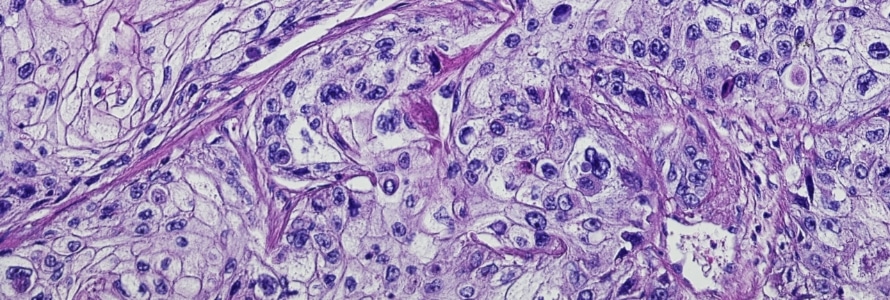
Screening, Diagnosis, Treatment and Management

Squamous cell carcinoma is the second most common form of skin cancer, right after basal cell carcinoma. It arises as an uncontrolled growth of abnormal squamous cells from the skin’s upper layers (the epidermis). Squamous cell carcinomas often look like scaly red patches, open sores, elevated growths, or warts that may crust or bleed. They are mainly caused by increased exposure to ultraviolet light (sun) over the course of a lifetime and at times, can become deadly if untreated. An estimated 700,000 cases of squamous cell carcinomas are diagnosed each year in the United States, resulting in approximately 2,500 deaths. If detected at an early stage and removed promptly, squamous cell carcinomas are almost always curable and cause minimal damage.
Where Squamous Cell Carcinoma Occurs
While it can appear on all areas of the body, including mucous membranes and genitals, this type of carcinoma is most common in frequently sun-exposed areas, such as the face, upper rim of the ears, bald scalp, neck, back of the hands, arms and legs. The skin in these areas often shows telltale signs of sun damage, such as wrinkling, freckling, and loss of elasticity.

Risk Factors and Causes of Squamous Cell Carcinoma
People with a higher risk of getting squamous cell carcinoma may have one or more of the following:
- Light-colored or freckled skin
- Blue, green, or gray eyes
- Blonde or red hair
- Skin that sunburns easily or has an inability to tan
Other risk factors include:
- Being outdoors for work or leisure, especially without using sun protection
- Indoor tanning
- Exposure to cancer-causing chemicals, tar, insecticides or herbicides
- Smoking tobacco
- Previous history of basal cell carcinoma
- Chronic infections and skin inflammation
Bowen's Disease
A superficial form of squamous cell carcinoma, called Bowen’s disease, or squamous cell carcinoma in-situ, may occur on sun-exposed or non sun-exposed skin, such as the genitalia. It appears as a persistent red-brown scaly patch that may resemble psoriasis or eczema. If untreated, it can progress to invasive squamous cell carcinoma. The human papilloma virus (HPV), which is highly transmissible through sexual contact, has been documented as a cause of one form of Bowen’s disease, affecting the genitalia.
Squamous Cell Carcinoma Treatment Options
Once Dr. Brian Mekelburg has diagnosed a patient with squamous cell carcinoma through a biopsy, a treatment plan can be made. A biopsy can be done quickly under local anesthesia during a routine visit, where Dr. Brian Mekelburg can get a sampling of the suspected tumor. The choice of treatment is based on the type, size, location, suspected depth of penetration of the tumor, the patient’s age and general health, and the likely cosmetic outcome of specific treatment.
Dr. Brian Mekelburg’s main goals for treatment are:
- Cure the tumor
- Make it look as pretty as possible
- Keep you relaxed
Types of treatments performed include:
Using local anesthesia, the cancerous growth is scraped off then any residual tumor cells are destroyed. The cosmetic outcome can be outstanding. C&D may not be the best option for aggressive carcinomas. > Learn More About Curettage and Electrodessication
The entire growth and surrounding areas are removed and then closed with stitches. Cure rates are in the 90 percent range. > Learn More About Excisional Surgery
The tumor and surrounding tissue is removed and examined under a microscope. This technique has the highest cure rate. > Learn More About Moh’s Micrographic Surgery
5-Fluorouracil and Imiquimod, both FDA-approved for treatment of actinic keratoses and superficial basal cell carcinomas. Imiquimod stimulates the immune system to destroy the cancer cells. It is also being tested for treatment of some superficial squamous cell carcinomas. 5-FU is a topical chemotherapy agent, which can directly destroy tumor cells. > Learn More About Imiquimod and 5-Fluoruracil
Done outside of our practice, radiation therapy is an option for patients with large cancers, especially in places where surgery is difficult (eyelids, ears, and nose), or for elderly patients, or those unable to tolerate surgery. > Learn More About Radiation
The screening, diagnosis and management of squamous cell carcinomas are a core commitment of our practice. Contact Los Angeles dermatologist, Dr. Brian Mekelburg for a consulation. Remember, if caught early, skin cancers are treatable and most likely curable!


